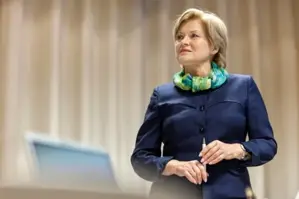What is an executive? Roles and responsibilities explained
What is an executive? Executives are the people who lead an organization toward success through leadership. Organizations may have multiple executives with varied responsibilities depending on size and structure. Aniday will help you understand executive functions and differences can help decide on pursuing such roles.
What is an executive?
An executive is a person who holds a high-level position within an organization and is responsible for making key decisions, managing operations, and guiding the company's strategic direction. Executives are typically involved in setting goals, developing policies, and overseeing the implementation of strategies to achieve the organization’s objectives. The CEO is ultimately responsible for the performance and success of the company, and they typically report directly to the board of directors or shareholders.

Find out information about "What is an executive?"
What is an executive responsible for?
An executive is responsible for a wide range of important duties within an organization. Here are the key responsibilities of an executive:
- Strategic leadership: Executives are responsible for setting the overall vision, mission, and strategic direction of the organization. They make major decisions that impact the company's long-term success.
- Operational oversight: Executives oversee the day-to-day operations of the business, ensuring that all departments and functions are running efficiently and effectively. This includes managing budgets, allocating resources, and monitoring performance.
- Risk management: Executives are responsible for identifying, assessing, and mitigating various risks that could impact the organization, such as financial, operational, and reputational risks.
- Driving change and innovation: Executives must be able to recognize the need for change and lead their organizations through transformations. This includes fostering a company culture of innovation and adapting to new market conditions and technological advancements.

Responsibilities of executive management position
What does an executive do?
Executives are responsible for leading the organization, formulating strategies, making key decisions, and managing day-to-day operations. They oversee finances, manage risks, and ensure that the team is working effectively to achieve the company's overall goals.
In addition, executives ensure that good relationships are maintained with stakeholders such as shareholders, partners, and customers. They build and develop the business, encourage innovation, and continually seek market expansion opportunities to enhance the organization's competitive position.

Company strategy management
Recommended for you:
9 executive positions in a company
Executive positions in a company are senior leadership roles that are responsible for developing and implementing the long-term development strategy of the organization. Each position is responsible for managing a specific functional area that affects the entire operation of the company. Aniday provides you with the main duties of executive positions in a company.
1. Executive Director
An Executive Director is a senior leadership position, typically found in non-profit organizations, businesses, or government agencies. They are responsible for managing day-to-day operations, implementing strategy, and ensuring the organization achieves its goals.
Key duties include leading staff, overseeing finances, building relationships with stakeholders, and representing the organization to the public. The role of the Executive Director is critical to maintaining the organization's growth and sustainable success.

Executive director
2. Vice President of Sales
The Vice President of Sales is an executive position responsible for leading and managing an organization's sales department. They develop sales strategies to achieve revenue goals, manage the sales team, and maintain relationships with key customers. Their role includes analyzing the market, adjusting sales strategies, and coordinating with other departments to ensure the growth and success of the company.

Vice President of Sales - Strategic Sales Planning
3. Chief Executive Officer
The Chief Executive Officer (CEO) is the highest-ranking executive in a company, responsible for making key strategic decisions and managing the overall operations of the organization. The CEO sets the long-term vision, ensures that the company's goals are achieved, oversees finances, and develops the team. They also represent the company to the board of directors, partners, and the public, playing a key role in leading the company to achieve success and sustainable development.

The responsibilities of a CEO
4. Chief Product Officer
The Chief Product Officer (CPO) is responsible for managing and developing the company’s product portfolio. They develop product strategies and oversee the entire process from concept to market launch. They ensure products meet customer needs and quality standards. The CPO also leads the product development team and conducts market analysis to optimize products and drive company success.

CPO - Developing a product roadmap
5. Chief Development Officer
The Chief Development Officer (CDO) is responsible for driving the strategic growth of the company through expansion and improvement opportunities. They focus on developing and implementing business development plans and process optimization. The CDO works closely with other departments to ensure that development initiatives align with the overall goals of the company and contribute to the sustainable growth of the organization.

CDO is a key executive leadership
6. Chief Compliance Officer
The Chief Compliance Officer (CCO) is responsible for ensuring that the organization complies with all legal regulations and ethical standards. They develop and implement compliance policies, and monitor operations. Resolve violations, and train employees on regulations. The CCO plays a vital role in protecting the organization from legal risks and maintaining the company's reputation.

Proceeding internal controls and policies
7. Chief Accounting Officer
The Chief Accounting Officer (CAO) is responsible for managing and overseeing the company's accounting operations. They ensure the accuracy of financial reports, and compliance with accounting and tax regulations, and oversee day-to-day accounting processes. The CAO plays a vital role in maintaining financial transparency and assisting management in making decisions based on accurate financial information.

CAO - a senior finance executive
8. Chief Technology Officer
The Chief Technology Officer (CTO) develops and implements technology solutions, oversees the technical team, and ensures that the company's systems and technologies meet business needs and support long-term goals. The CTO drives innovation and maintains the organization's technological competitive advantage.

The Chief Technology Officer - manage the technology team
9. Chief Marketing Officer
A Chief Marketing Officer (CMO) is a key position in a corporation, responsible for developing and implementing the company's marketing strategies. They manage brand promotion activities, market research, and optimize communication campaigns to increase the company's presence in the market and drive revenue. CMOs play a key role in building and maintaining brand image and connecting with customers.

CMO -Approve marketing campaign ideas
What's the difference between an executive and a manager?
This comparison shows that executives are involved in higher-level strategy and vision while managers focus on operational efficiency within their teams or departments. Here’s a table outlining the key differences between an executive and a manager:
| Feature | Executive | Manager |
| Level in organization | Top-level | Mid-level or senior-level |
| Scope of responsibility | Wide-ranging, organization-wide decisions | Specific department or team-focused |
| Decision-making | Strategic, long-term decisions | Short-term operational decisions |
| Focus | Long-term goals, visions, and direction | Short-term goals, daily operations |
| Risk management | Identifies and manages large-scale risks | Manages risks related to specific projects or departments |
| Relationship with employees | Define direction and provide resources | Directly supervises and mentors employees |
Thank you for reading Aniday’s article “What is an executive? Roles and responsibilities explained”. We hope that the information in the article has helped you better understand the roles and responsibilities of executives in an organization. If you have any questions or need more recruitment information, please contact us immediately.
Things you may like:
Aniday's HR Services
Headhunting Service
Find and recruit quality candidates in just 1 week! Supported by 40,000 experienced headhunters in IT, Finance, Marketing… capable of recruiting in any region.
Headhunting Service ➔Employer of Record (EOR) Service
On behalf of your business, we recruit employees and handle payroll without the need to establish a company in markets such as Vietnam, Singapore, Malaysia, India, Indonesia…
Employer of Record (EOR) Service ➔